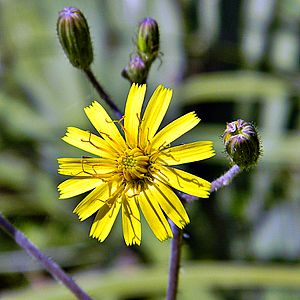Coastal plain hawkweed facts for kids
Quick facts for kids Coastal plain hawkweed |
|
|---|---|
 |
|
| Coastal plain hawkweed (Hieracium megacephalon | |
| Scientific classification | |
| Genus: |
Hieracium
|
| Species: |
megacephalum
|
| Synonyms | |
|
Hieracium megacephalon Nash |
|
The coastal plain hawkweed (scientific name: Hieracium megacephalum) is a type of plant found in North America. It belongs to the same plant group as dandelions, which is part of the larger sunflower family. This plant is special because it only grows in certain parts of the southeastern United States.
About the Coastal Plain Hawkweed
The coastal plain hawkweed is a fascinating plant. Its scientific name, Hieracium megacephalum, helps scientists around the world know exactly which plant they are talking about. It was first described by a botanist named George Valentine Nash in 1895.
Where Does It Grow?
This unique plant is found only in the southeastern United States. You can spot it growing in states like Georgia, Florida, and the Carolinas (both North and South Carolina). It prefers the flat, low-lying areas often found near coastlines, which is why it's called the "coastal plain" hawkweed.
What Does It Look Like?
The coastal plain hawkweed is an herb, which means it's a plant without a woody stem. It can grow up to about 40 centimeters (or 16 inches) tall.
- Leaves: It has leaves both along its main stem and in a special cluster at the very bottom. This cluster of leaves at the base is called a rosette, and it looks a bit like a circular pattern. These leaves can be up to 120 millimeters (about 4.7 inches) long. Sometimes, they even have small teeth along their edges.
- Flowers: One coastal plain hawkweed plant can produce many flower heads, sometimes as many as 50! These flower heads grow in a flat-topped group. Each individual flower head has between 20 and 50 bright yellow "ray flowers." These are the petal-like parts you see. Interestingly, unlike some other plants in the sunflower family, it does not have "disc flowers" in the center.

